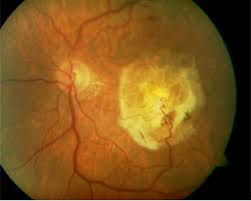Specialist Ophthalmologist
B.Sc. (UOFS), B.OPTOM. (UNIN), F.O.A. (S.A.), MB. ChB. (Stell), F.C. OPHTH. (S.A.), M. MED. OPHTH. (Stell)
ARMD
What Is Age-Related Macular Degeneration?
Macular degeneration is the leading cause of severe vision loss in people over age 60. It occurs when the small central portion of the retina, known as the macula, deteriorates. The retina is the light-sensing nerve tissue at the back of the eye. Because the disease develops as a person ages, it is often referred to as age-related macular degeneration (AMD). Although macular degeneration is almost never a totally blinding condition, it can be a source of significant visual disability.



There are two main types of age-related Macular degeneration – as can be seen above:
Dry form. The “dry” form of macular degeneration is characterized by the presence of yellow deposits, called drusen, in the macula. A few small drusen may not cause changes in vision; however, as they grow in size and increase in number, they may lead to a dimming or distortion of vision that people find most noticeable when they read. In more advanced stages of dry macular degeneration, there is also a thinning of the light-sensitive layer of cells in the macula leading to atrophy, or tissue death. In the atrophic form of dry macular degeneration, patients may have blind spots in the center of their vision. In the advanced stages, patients lose central vision.
Wet form. The “wet” form of macular degeneration is characterized by the growth of abnormal blood vessels from the choroid underneath the macula. This is called choroidal neovascularization. These blood vessels leak blood and fluid into the retina, causing distortion of vision that makes straight lines look wavy, as well as blind spots and loss of central vision. These abnormal blood vessels and their bleeding eventually form a scar, leading to permanent loss of central vision.
What Are the Risk Factors for Macular Degeneration?
As the name suggests, age-related macular degeneration is more common in older adults. In fact, it is the leading cause of severe vision loss in adults over age 60.
Macular degeneration may be hereditary, meaning it can be passed on from parents to children. If someone in your family has or had the condition you may be at higher risk for developing macular degeneration. Talk to your eye doctor about your individual risk.
Smoking, high blood pressure, high cholesterol, obesity, and being light skinned, female, and having a light eye colour are also risk factors for macular degeneration.
What Are the Symptoms of Macular Degeneration?
In its early stages, macular degeneration may not have symptoms and may be unrecognized until it progresses or affects both eyes. The first sign of macular degeneration is usually a dim, blurry spot in the middle of your vision. This spot may get bigger or darker over time.
Symptoms of macular degeneration include:
- Dark, blurry areas in the centre of vision
- Diminished or changed colour perception
How Is Macular Degeneration Diagnosed?
Age-related macular degeneration can be detected in a routine eye exam. One of the most common early signs of macular degeneration is the presence of drusen — tiny yellow deposits under the retina — or pigment clumping. Your doctor can see these when examining the eyes.